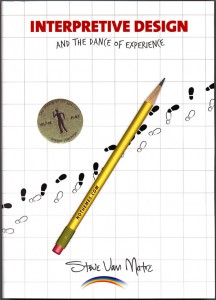 Interpretive Design
Interpretive Design

 nterpretation is the craft of enriching the experience of leisure visitors with places established for the public good. The world’s parks and preserves, gardens and galleries, monuments and museums are the jewels of our societies, set aside because they represent the natural and cultural treasures we want to celebrate today and share with others tomorrow.
nterpretation is the craft of enriching the experience of leisure visitors with places established for the public good. The world’s parks and preserves, gardens and galleries, monuments and museums are the jewels of our societies, set aside because they represent the natural and cultural treasures we want to celebrate today and share with others tomorrow.  As a result, they are mission-driven places which also need to justify and garner support for what they are protecting. An interpreter translates the natural and cultural language of such places for its visitors, while immersing them in the essence of its purpose. Interpretive designers create the leisure journeys that interpreters implement. Just as we have designers today for the buildings, signs, grounds, exhibits, and other components of our mission-driven public places, we need “interpretive designers” who focus on the most important component, the actual experience of the visitors who come. This is a new profession which works with the whole experience that other designers only facilitate in part. Interpretive designers create the interrelated experiential vehicles of interpretive service.
As a result, they are mission-driven places which also need to justify and garner support for what they are protecting. An interpreter translates the natural and cultural language of such places for its visitors, while immersing them in the essence of its purpose. Interpretive designers create the leisure journeys that interpreters implement. Just as we have designers today for the buildings, signs, grounds, exhibits, and other components of our mission-driven public places, we need “interpretive designers” who focus on the most important component, the actual experience of the visitors who come. This is a new profession which works with the whole experience that other designers only facilitate in part. Interpretive designers create the interrelated experiential vehicles of interpretive service.
Design is the mental process behind the act of bringing something into being. It is usually problem-solving (a desire to improve upon something), or task-driven (a need to come up with something), and it usually involves products – indeed, that may be what separates it from daydreaming – but those products can be objects or actions, spaces or events. The important thing to hold onto is that design is the process, not the product. It is what happens in the mind between problem and potential. (Architects design structures; they don’t build them.) In short, a designer creates a plan for something to be produced. There’s an outcome in mind, and the watchwords for that outcome are integrity, coherence, and harmony (exactly what’s missing in much of interpretation). It is the role of the interpretive designer to work with the staff of our public treasures to conceptualize an overall experiential plan for their visitors within the context of the public mission their site proclaims, and then serve as a coordinator and catalyst for the work of other design professionals as needed. Interpretive designers help sites mold their interpretive facilities around the outcomes they intend rather than the structures they inherit. The operative term here is “experiential plan.” By starting with the experiences rather than the structures – experiences wedded to the place and its purpose – a designer crafts a plan of actions rather than words for the visitors. And these “inter-actions” with the place are designed for specific interpretive outcomes, not added on for their own sake. Without a carefully worked out plan, interpretation veers off course easily or ends up circling its own ambitions endlessly.

